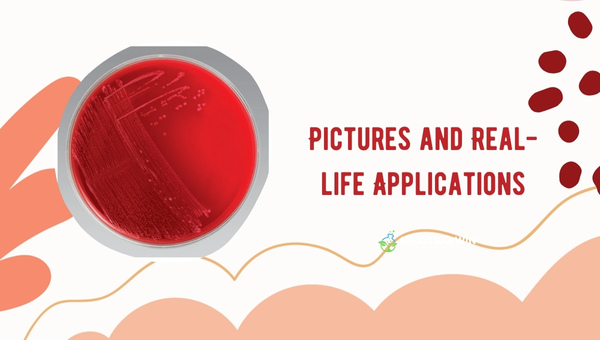Physical Address
304 North Cardinal St.
Dorchester Center, MA 02124
Blood Agar, a staple in every microbiology lab, is the unsung hero that plays an essential role behind the scenes. It’s an enriched medium that facilitates the growth of various bacteria for study and diagnostic purposes. Perhaps you’ve always wondered about its composition, or maybe how exactly it is made and used?
In this blog post, we’ll unravel every bit of information about Blood Agar- from what it’s composed of, how to prepare it, and all the different uses it has to handy pictures demonstrating its real-time usage.
Whether you’re an enthusiast wanting to dip your toes into bacteriology or a student looking for some quick revision materials – there’s something in here for everybody! So stick around as we delve deeper into this intriguing world of microbiology.
Contents
When we speak of Blood Agar in the realm of microbiology, what exactly do we mean? Well, imagine a substance that provides the perfect environment for a wide range of bacteria to grow and develop. That’s what blood agar essentially is – an enriched bacterial growth medium.

Leaning more on its specification, Blood Agar is comprised of general nutrients and 5% sterilized sheep blood. It’s this unique composition that makes it a fantastic base for bacteria to thrive on, facilitating their observable growth and allowing us to study various characteristics they exhibit!
So, have you ever wondered what exactly Blood Agar means in microbiology? Essentially, it is an enriched bacterial growth medium, teeming with nutrients that foster microbial proliferation. Composed mostly of standard agar base supplemented with 5% sheep blood, it is used extensively for culture media in laboratories.
Playing a central role in investigating and identifying pathogens, blood agar’s importance extends far beyond just providing a nutrient base. It acts as the stage where various microorganisms play out their distinctive characteristics in response to the environment they are grown in, making it quintessential for several diagnostic tests.
Also Read: How Do Family Trees Work? Unraveling The Intricacies
The key to understanding how this fascinating medium works starts with dissecting its composition. At a closer look, you’ll find that blood agar isn’t just any random concoction; it’s thoughtfully crafted, with each component adding value to the whole.
Primarily, blood agar consists of mostly a standard nutrient agar base supplemented with 5% defibrinated sheep or horse blood.
The medium provides not just a nutritionally rich base for the microorganisms to thrive on but also serves as an indicator for differentiating among various species based on their hemolytic reactions. It’s this unique composition that sets blood agar apart!
The essential elements of blood agar begin with the standard nutrient agar base, composed primarily of peptides, amino acids, and carbohydrates, which provide nourishment to the microbes. But the true magic lies in the addition of 5% defibrinated sheep or horse blood that makes this medium so effective.
A key component, the blood, adds an extra layer of differentiation by helping us distinguish between bacteria based on their hemolytic reactions.
Each type will have a unique response to the properties within the mix, displaying various traits and characteristics – allowing us to identify different bacterium more accurately. It’s this ensemble of components that contributes significantly to fostering bacterial growth, making each one indispensable!
Also Read: How Do Family Trees Work? Unraveling The Intricacies
Ever wondered how this magical concoction is prepared? The process is as interesting as it sounds. Here’s a simple step-by-step guide to making your own basic blood agar medium.
You start with dissolving the base nutrients in distilled water, heating them until boiling for sterilization, then cooling them down to around 50 degrees Celsius before adding defibrinated blood.
But hold on! Before you start playing mad scientist, there are key precautions to remember. Hygiene tops the list; always wear gloves and use sterilized containers. Stability in temperature is crucial – no using too hot or too cold solutions!
Also, remember to handle the blood component with utmost care since it can be a source of infection. It’s all about accuracy and safety when preparing your own batch of blood agar material.
The preparation of Blood Agar involves a meticulous yet rewarding process. So, let’s walk through the steps.
First, you dissolve nutrients in distilled water and heat this solution till it boils. After sterilization, let it cool down until it reaches around 50 degrees Celsius before bringing blood into the picture.
And voila! You slowly add the defibrinated blood to this lukewarm mix. Stir the mixture gently to ensure an even distribution of blood throughout the medium, and then pour into sterile Petri dishes and allow it to solidify. There, you have your own prepared plates of blood agar!
While preparing Blood Agar may seem fascinating, safety should take precedence over curiosity. Exemplary hygiene is a must – ensure that gloves are worn at all times, and all containers used are adequately sterilized.
Also, be absolutely cautious about maintaining stability throughout the process – sudden temperature shifts can adversely affect your product output!
Likewise, remember that handling defibrinated blood requires utmost care; after all, prevention is better than cure! By following these precautions, you not only safeguard yourself but also ensure the integrity of your blood agar preparation.
Also Read: Isostatic Rebound: Uncovering Post-glacial Rebound Process
Blood agar, while it may appear only a simple part of Petri dishes in labs, holds an expansive array of uses across the fields of bacteriology and medical microbiology.
Thanks to its nature as an enriched medium, it opens new doors to pathogen growth, identification, and even more.
Medical microbiology relies heavily on the use of Blood Agar. That’s because bacteria love to grow on this nutrient-rich medium. The added presence of animal blood allows for more diverse species of bacteria to thrive.
This means we can grow, study, and identify numerous types of common and uncommon pathogens alike using these plates – including Streptococcus species, which are responsible for anything from strep throat to meningitis!
This is where things get interesting! Blood Agar takes things one step further by letting us differentiate between different types of bacteria based on their unique hemolytic reactions. Simply put – some bacteria create enzymes that break red blood cells in distinctive ways!

By observing their special ‘footprints’ – clear (beta-hemolysis), greenish (alpha-hemolysis), or no change (gamma-hemolysis) – we can tell more about what we might be dealing with! It’s kindred to solving a detective mystery right inside your Petri dish. Pictures and Real-life Applications
Before we dive into talking about blood agar’s utilization in real-life applications, allow me to paint a visual image using words.
Imagine a petri dish containing a semi-solid, nutrient-rich red substance with distinct areas featuring various degrees of color change – some spots appearing clear, others partially greenish, yet others remaining unchanged. This is what Blood Agar looks like when serving its purpose.
Now, onto reading these visually captivating results! While pictures relay a thousand words, it is important to understand how each color shift corresponds to different hemolytic reactions and, thus, different bacteria. As mentioned earlier:
These varied reactions aren’t just colorful displays but provide us valuable clues in identifying many pathogens related to human disease in real time!
Also Read: Sabouraud Dextrose Agar (SDA): Composition, Uses, and More
While the preparation is straightforward, handling Blood Agar requires care due to potential risks from exposure to pathogens; hence, professional supervision is advised.
Many types of bacteria, including Streptococcus species and Pneumococcus, can be identified by their distinct hemolytic reactions on a blood agar plate.
Ready plates should be stored in a cool location, ideally in the refrigerator at about 4 degrees Celsius, and used within two weeks.
Yes, with careful attention to hygiene, temperature stability, and sourcing defibrinated blood, one can prepare blood agar at home.
Blood agar provides a nutrient-rich environment and allows differentiation between bacteria based on their hemolytic reactions, making it great for bacterial culture growth.
Also Read: Unveiling MacConkey Agar: Composition, Principles, and Uses
There you have it! From understanding what Blood Agar is, all the way to interpreting reactions and identifying different bacteria, we’ve covered it all. Remember, this nutrient-rich medium is more than just a component in a petri dish; it’s your gateway into detecting and distinguishing a myriad of bacteria and aiding diagnostic processes.
As we conclude our delve into the world of blood agar, I hope you take away a newfound respect for this fundamental resource used widely across microbiology labs. Whether as an enthusiast exploring bacteriology or as a professional operating in the field – having profound knowledge about Blood Agar is undoubtedly an indispensable asset.